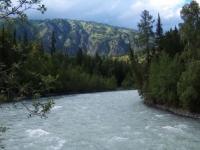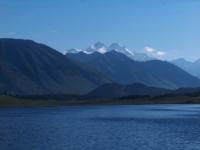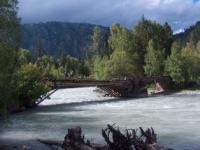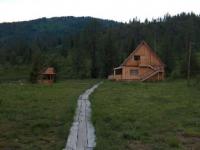You are here
Katon-Karagay Natural Park.




Katon-Karagay national Park tours.
“Nature abhors annihilation”
Marcus Tullius Cicero.
Sights of Katon-Karagay national Park.
In the summer of 2001 a huge 1300-square-kilometre area in the Altai was declared a national park. It includes almost the entire territory between the borders with Russia and China, the villages of Soldatovo and Medvyedka and the northern slopes of the Sarymsaktiy and Tarbagatay.
Though Katon-Karagay National Park does not have the strictest protective status, it has improved the situation by imposing more severe penalties on poachers and hunters of the endangered species that inhabit this region.
The largest in Kazakhstan Katon-Karagaysky national park with total area of 643,5 thousand hectares, occupies the valley of the Buhtarma river in it upper courses, linked up in western part with two protected territories of Russia - Katunsky biospheric nature reserve and Ukok zone of rest. In territory of Russia there is Altai - the oldest and largest nature reserve of the region.
It was founded in 1932 and occupies the territory of 881 thousand hectares that is 9,4 % of all territory of Russian Altai. The highest top is Kurkure-Bezhi Mountain (3110 meters) which is located in Shapshalsky ridge system, dividing Ob and Yenisei river basins.
Unique riches of taiga woods, high-altitude tundra, chared deserts and low-hill steppes, about 1500 species of higher plants, about 70 kinds of mammals, more than 300 kinds of birds, 15 kinds of fishes etc are remained there.
Altai nature reserve is well-known lake-land. Among more than 2500 lakes the most interesting is glacial Dzhulukul Lake which area reaches about 30 sq.km and maximum depth is 10 metres.
Korbu waterfall produces unforgettable impression as it is the most entertainment tourist attraction on the east coast of Teletsky Lake - western border of Altai nature reserve. This measure became necessary because of the increasing impact of steadily growing tourism, and because of the increasing exploitation of natural resources by the local population during the 1990s.
It's important to note that most of the families in this area's villages are extremely poor; many move out and head for the cities, and the villages begin to stagnate, while those who remain take what they need for their daily survival from the forest.
When traders, mainly Chinese, began 10 come in increasing numbers illegally to buy maral antlers, brown bear bile, and the ascent glands of certain rare species, the temptation to poach animals was strong, as a single animal could garner a poacher the equivalent of a month's income.
Inevitably the wildlife populations of threatened species declined, but as penalties became more severe, poaching has become less appealing. Other measures have also been employed to combat the problem; the most significant is the successful "farming domestic marals for the medicinal extract pantocrine that is found in abundance in then newly formed antlers.
The region's main town, also called Katon-Karagay is situated on the Narym Valley floor. Small and neat, it has a tiny museum dedicated to the famous Kazakh novelist Oral Khan Bokeh who was born here and lived in a tiny house that houses the museum, displaying paraphernalia Bokeh's life, including gifts presented to him from admirers during his travels. There is talk of an airport being built in the valley near to Katon-Karagay; this would of course result in development and economic progress for the local population, but responsible tourism growth is a must.
Local officials seem to understand this, and hope to develop tourism models that preserve the ecology and culture while allowing more visitors into the region, improving living standards for local people without causing irrevocable damage to their land.
The territory of the national park became the part of the designed area of Kazakh part of Altai-Sayan ecoregion. The area of the park is 643.477 thousand ha. The park has richest natural resources and the unique spectre of the landscapes.
Forests, which are the main wealth of the park, constitute 34% of its territory and are represented by mainly coniferous species. Flora and fauna is also diverse. There are species, which are in the Red Book.
One of the main objectives of the park is to create the conditions for the regulated tourism and holidays. Basic accent is made on the development of the ecological tourism, which provides for the presence of certain and stricter behaviour rules than on the usual tourist routes.
The basis of ecotourism is the acknowledgment of the nature values, safe and careful attitude to nature. With this purpose in the national park on the basis of the demanded route there is the recreation-cognitive ecologic path “White Berel”, the purpose of which is to save and to recreate the biological diversity of the natural landscape.
Belukha area is attractive for tourists. It contains popular zones along White Berel River, in the area of the Lower camp near Kokkol Mine and sanatorium “Rakhmanov Springs”. In Berel affiliate of KKSNNNP, in Uryl village there is a visiting centre for guests, visitors and tourists.
Here the workers of the park can talk to tourists, show then booklets, pictures and make excursions around the village and its area. People from Katon-Karagai area are very hospitable.
There are special guest houses arranged in the villages of Uryl, Berel, Chernova, Topkaiyn, Korobikha located near the unique natural and historical sites.
Authority:
“Central Asia Mountains”. 2009, Almaty,Publishing house “Mektep”. Authos Aldar Gorbunov, Anna Ivachenko, Sharipa Bisarieva.
Photos
Alexander Petrov.







